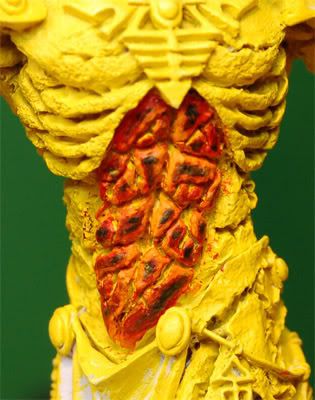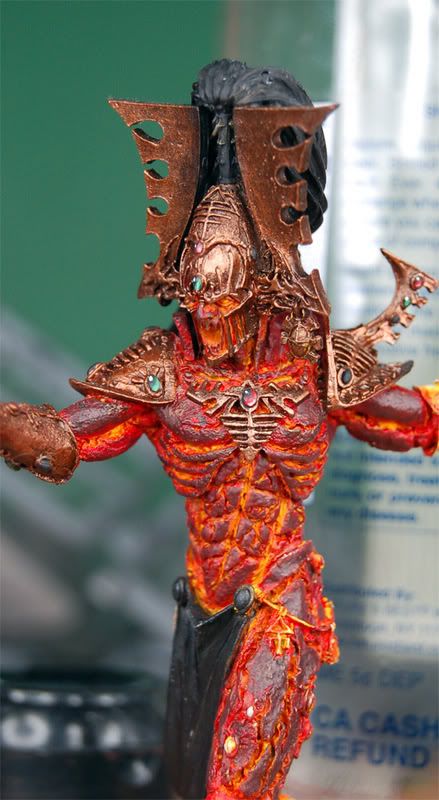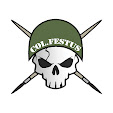Hey guys, Col_Festus here. I want to introduce a new series that I will be running. I call this series Master Class. These articles will focus around a miniature or sets of miniatures that I have deemed master class quality. So grab your brushes recruits!
These articles will take you through the process involved when I create a master class level miniature. This will include the ideas behind the miniatures conversions/paint jobs such as the imagery and emotions I wanted to capture with the piece. I will also be detailing the processes used in creating the miniature such as painting techniques and the like. Some of these techniques will not be for the beginner, often involving different mediums such as oil paints, or specialty tools like an airbrush.
I want to start the series off with a model that changed the way I paint. Before this model I used to paint based off of GW tutorials and never really found my "style" as an artist. I was great at replicating paint jobs and they looked good on the table. Bright colors, crisp lines, and extreme highlights. This miniature challenged that style of painting, and began me on a road to painting more realistic miniatures. The model I will kick this series off with is Forgeworld's beautiful Avatar of Khaine.
I had a lot of feedback asking me to detail the technique involved in the lava effects on the Avatar. The process was a very tedious one. Often including in some places up to 10 levels of reverse highlighting. I will do my best to explain how I achieved these results. Bear with me as I painted this model almost two years ago, however I feel I took enough pictures to help get the technique across. So here we go.
Initially this item was brought to me as a commission piece. They asked me to “capture the fury of Khaine” with the paint job. As I was doing the research on various techniques to try out to do this I realized that GW’s bright highlights and typical Eldar style of painting just wouldn’t do. Enter realism. I began looking at images of lava and decided I wanted to really capture the feeling of an erupting volcano. I wanted the model to be searing with fury. So I planned out a technique in my head and began painting.
I call the technique I used “reverse highlighting”. This involves starting with the lighting color and working your way backwards. In this case I sprayed the model white and put a solid layer of Sunburst Yellow down on the miniature. From there I started the technique on a small section of the model. In this case is abdomen. I wanted to make sure it had the right look to it before I began working on the broader areas. I began the reverse highlighting by painting a 1:1 mixture of Sunburst Yellow and Blazing Orange. I made sure to leave some yellow showing through. I then took pure Blazing Orange and added that to the previous stage, once again leaving a little bit showing around the “crust” of the lava. A bit of wet blending maybe required at this stage to get it looking just right. Experiment a bit until you are satisfied with the results. This helped to create the glowing effect.

After this was complete I moved onto the charred section of the crust. I knew I wanted to go all the way to black to really give the felling of lava and to make the miniature “pop” on the table. I used the same technique detailed previously only with Blood Red and Blazing Orange. Once again when after this was complete I used straight Blood Red. Repeat the process with Blood Red and Scab Red. It’s worth noting here that scab red can be an extremely fickle color to work with. Make sure you use a few layers to get a nice solid layer before moving on to the final level of reverse highlights. This is what it should look like at this stage.

The final stage is using the same technique yet again but with Scab Red and Chaos Black. Finish the sections with Chaos Black in irregular patterns in the middle of the “lava plates”. To finish the effect you can mix a bit of Skull White with Sunburst yellow and paint thin lines in the deepest cracks on the model. This will give the effect of white-hot lava. This is how I achieved the intensity of the mouth and eyes on the model.
That should just about finish up the lava technique that so many of you were curious about. I went on to finish the model with my gemstone technique and some Brazen Brass metallic work. I topped it all off with a hand painted craftworld symbol using bleached bone. I based it to match the clients army and called it a day. The model received a matte varnish using the old Testors Dullcote formula (Sadly no longer available in the States). Here are a few shots of the finished product.
~So there you have it folks. Ask and you shall receive. I hope you enjoyed the first of my Master Class series. As always any questions shoot them to my email. Col.festus@gmail.com
